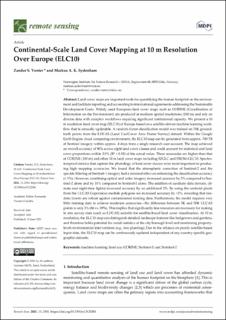| dc.contributor.author | Venter, Zander | |
| dc.contributor.author | Sydenham, Markus A. K. | |
| dc.coverage.spatial | Europe | en_US |
| dc.date.accessioned | 2021-06-17T08:27:20Z | |
| dc.date.available | 2021-06-17T08:27:20Z | |
| dc.date.created | 2021-06-14T13:15:06Z | |
| dc.date.issued | 2021 | |
| dc.identifier.issn | 2072-4292 | |
| dc.identifier.uri | https://hdl.handle.net/11250/2759895 | |
| dc.description.abstract | Land cover maps are important tools for quantifying the human footprint on the environment and facilitate reporting and accounting to international agreements addressing the Sustainable Development Goals. Widely used European land cover maps such as CORINE (Coordination of Information on the Environment) are produced at medium spatial resolutions (100 m) and rely on diverse data with complex workflows requiring significant institutional capacity. We present a 10 m resolution land cover map (ELC10) of Europe based on a satellite-driven machine learning workflow that is annually updatable. A random forest classification model was trained on 70K groundtruth points from the LUCAS (Land Use/Cover Area Frame Survey) dataset. Within the Google Earth Engine cloud computing environment, the ELC10 map can be generated from approx. 700 TB of Sentinel imagery within approx. 4 days from a single research user account. The map achieved an overall accuracy of 90% across eight land cover classes and could account for statistical unit land cover proportions within 3.9% (R2 = 0.83) of the actual value. These accuracies are higher than that of CORINE (100 m) and other 10 m land cover maps including S2GLC and FROM-GLC10. Spectrotemporal metrics that capture the phenology of land cover classes were most important in producing high mapping accuracies. We found that the atmospheric correction of Sentinel-2 and the speckle filtering of Sentinel-1 imagery had a minimal effect on enhancing the classification accuracy (< 1%). However, combining optical and radar imagery increased accuracy by 3% compared to Sentinel-2 alone and by 10% compared to Sentinel-1 alone. The addition of auxiliary data (terrain, climate and night-time lights) increased accuracy by an additional 2%. By using the centroid pixels from the LUCAS Copernicus module polygons we increased accuracy by <1%, revealing that random forests are robust against contaminated training data. Furthermore, the model requires very little training data to achieve moderate accuracies—the difference between 5K and 50K LUCAS points is only 3% (86 vs. 89%). This implies that significantly less resources are necessary for making in situ survey data (such as LUCAS) suitable for satellite-based land cover classification. At 10 m resolution, the ELC10 map can distinguish detailed landscape features like hedgerows and gardens, and therefore holds potential for aerial statistics at the city borough level and monitoring propertylevel environmental interventions (e.g., tree planting). Due to the reliance on purely satellite-based input data, the ELC10 map can be continuously updated independent of any country-specific geographic datasets machine learning; land use; CORINE; Sentinel-1; sar; Sentinel-2 | en_US |
| dc.language.iso | eng | en_US |
| dc.rights | Navngivelse 4.0 Internasjonal | * |
| dc.rights.uri | http://creativecommons.org/licenses/by/4.0/deed.no | * |
| dc.subject | Maskinlæring | en_US |
| dc.subject | Machine learning | en_US |
| dc.subject | Arealbruk | en_US |
| dc.subject | Land-use | en_US |
| dc.title | Continental-Scale Land Cover Mapping at 10 m Resolution Over Europe (ELC10) | en_US |
| dc.type | Peer reviewed | en_US |
| dc.type | Journal article | en_US |
| dc.description.version | publishedVersion | en_US |
| dc.rights.holder | © 2021 by the authors | en_US |
| dc.subject.nsi | VDP::Matematikk og naturvitenskap: 400 | en_US |
| dc.subject.nsi | VDP::Mathematics and natural scienses: 400 | en_US |
| dc.source.volume | 13 | en_US |
| dc.source.journal | Remote Sensing | en_US |
| dc.identifier.doi | 10.3390/rs13122301 | |
| dc.identifier.cristin | 1915593 | |
| dc.relation.project | Norges forskningsråd: 302692 | en_US |
| dc.source.articlenumber | 2301 | en_US |
| cristin.ispublished | true | |
| cristin.fulltext | original | |
| cristin.qualitycode | 1 | |

